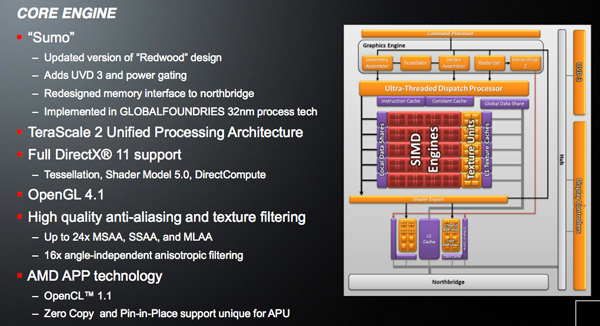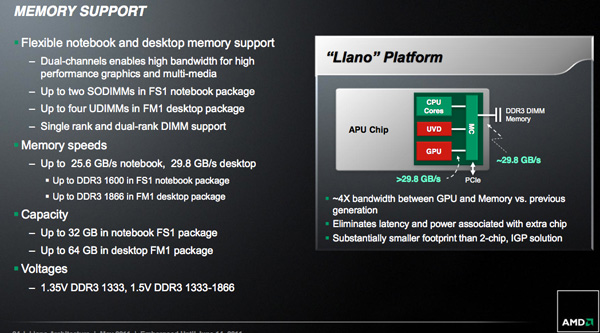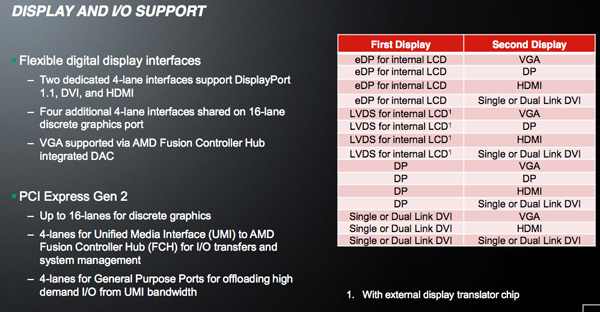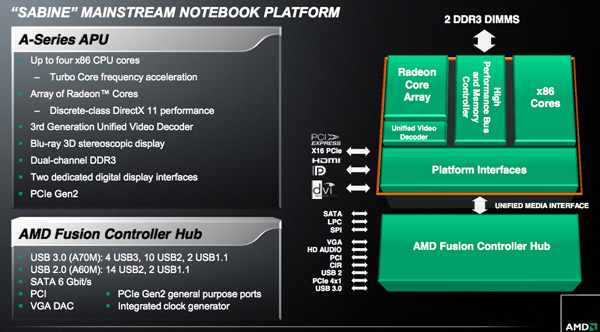The AMD Llano Notebook Review: Competing in the Mobile Market
by Jarred Walton & Anand Lal Shimpi on June 14, 2011 12:01 AM ESTThe GPU
While the Llano CPU cores may be in need of a major overhaul, Llano's GPU is as new as it gets. Technically based off of AMD's Redwood core (Radeon HD 5570) with some enhancements, Llano's GPU is codenamed Sumo.
The DX11 GPU features five SIMD arrays, each with 80 cores for a total of 400 shader processors. Similar to the updates we saw with this year's Northern Islands GPUs, Sumo does add UVD3 support to the Redwood architecture. Of course since Sumo shares the same die as the Llano CPU cores it is built on GlobalFoundries' 32nm process, making this the first AMD GPU fabbed at GlobalFoundries and not TSMC.
For everything behind the memory controller Sumo is virtually identical to Redwood. Where Sumo differs is in its memory interface. Although Llano is AMD's first performance oriented APU, it's still constrained by a 128-bit wide DDR3 memory interface. That dual-channel memory interface has to be shared by all four Llano cores as well as the Sumo GPU and as a result, arbitration is very important.
AMD shared a few choice details about the Llano memory controller architecture. To begin, AMD guarantees more than 30GB/s of bandwidth is available between the GPU and the memory controller—in other words, the path from GPU to the memory controller won't become a bottleneck. The GPU/memory controller link (i.e. within the APU die) can apparently scale up to as much as 50GB/s to support future APUs with even faster memory interfaces. Note that unlike previous integrated graphics solutions, there is no support for dedicated external memory—this is a pure shared memory architecture.
Second, and most importantly, AMD can dynamically prioritize memory bandwidth between the CPU and GPU. In most cases, when both processors are heavily consuming data, the GPU is given priority over the CPU. Given today's workloads, prioritizing the GPU for memory accesses makes sense when it's running full tilt. The chances of you stressing all four CPU cores and running at full GPU memory bandwidth requirements are pretty slim today.
With 400 shader processors behind a shared 128-bit DDR3 memory interface, the upper bound for Sumo performance is the Radeon HD 5570. In practice, you should expect performance to be noticeably lower since the GPU does have to share its precious memory bandwidth with up to four x86 CPU cores.
The mobile version of Llano supports up to DDR3-1600 while the desktop parts can run at up to DDR3-1866. Maximum memory capacities are 32GB and 64GB for notebooks and desktops, respectively.
Llano has a total of 24 PCIe Gen 2 lanes at its disposal. Sixteen of those lanes can be used for external graphics. Four of the lanes can be used for devices that need low latency/high bandwidth access to the APU itself (e.g. Gigabit ethernet). The remaining four lanes are used to connect the APU to its sole partner in crime: the Fusion Controller Hub.
AMD is particularly proud of the display output configurations supported by Llano. The possible combinations are listed below:
Chipsets
AMD will offer two Fusion Controller Hubs (FCHs) as options for Llano: A70M and A60M. The only difference between the two is in their support for USB 3.0; the A70M has four USB 3.0 ports while the A60M has none.
Both FCHs support 6Gbps SATA and perform just as well as AMD's 8-series chipset (or Intel's Z68) with a high performance SSD. USB 3.0 performance is also comparable to 3rd party solutions we've seen deployed on motherboards already.















177 Comments
View All Comments
DanNeely - Tuesday, June 14, 2011 - link
Just looking at transistor count misses most of the story. The highly repetitive layout in the GPU allows for much denser transistor layout, the die is only 5% larger. That's close enough that factors like yield and raw per wafer cost become at least as important.Lunyone - Tuesday, June 14, 2011 - link
Looks like we're finally getting close to having integrated graphics good enough for some good light gaming :) Hopefully these won't be priced to high to sell. There are sooo many Sandy Bridge based laptops out there that are within the $500-600 price range it isn't even funny. I hope we can get the top of the line Llano for about $600-650. I think the C50 or E-350 have been relegated down to tablet only now, since Llano is where it's at now.ET - Tuesday, June 14, 2011 - link
Brazos will likely keep its place at the lower price point and smaller size laptops. It would be interesting to see if the larger E-350 laptops will be replaced by Llano or will survive. I was surprised they were even introduced, but it's possible that if people are buying them they will continue to do so.Still, I'm hoping that Llano can make it into small form factor laptops.
Beenthere - Tuesday, June 14, 2011 - link
I am definitely ready to buy a Llano powered laptop. I suspect Llano will suit the needs of the largest notebook segment and deliver better graphics at a lower price point. AMD is bound to take notebook market share from Intel. I wouldn't ever consider an Intel product.RussianSensation - Tuesday, June 14, 2011 - link
What? The largest notebook segment doesn't care about GPUs in a laptop. Look at Apple - a non-gaming platform more or less - and quarter after quarter has the highest growth in the notebook market share. The fact that Intel HD graphics command #1 market share in the mobile and desktop space also shows that the the majority of consumers don't care about mobile graphics beyond watching HD content.So with Llano you get a GPU that's still only fast enough for 1368x768 resolution gaming at the lowest settings and CPU performance that's only as fast as a Q6700 from 2007. Llano only makes sense if you are on a budget to buy a laptop. If you care about CPU performance, it's too slow. If you care about GPU performance, it's again too slow. So the only customer it will find is a niche one until they can create an APU with Bulldozer cores inside and a much faster GPU.
We have also seen a significant surge in consumers that desire premium made notebooks. Llano designs will likely be relegated to cheap looking and cheap quality laptops. Certainly it wont be able to compete with Ultrabooks.
I am almost certain that most of today's consumers will care about screen resolution, an SSD, the quality of the screen/materials build quality of the laptop before even thinking about the fact that Llano's GPU is faster than Intel's. Then there is AMD's past history of having unimpressive mobile CPUs over the last 5+ years. It's going to take 2-3 generations before consumers even think about switching brands in such a scenario. Most people will just buy an Intel based SB notebook simply because Intel has made the best mobile processor for the last "forever".
This is a good step for AMD, but they have a long road ahead.
duploxxx - Tuesday, June 14, 2011 - link
The share count is no longer relevant since an IGP is deployed anyhow with each system, while there are many delivered with discrete it still counts as an IGP also.Have a look at your so called apple highest growth market... it ships with discrete ATI graphics.....
Actually most don't know that the IGP is crappy, they are fooled by adiot sales and large electronic vendors who try to push there margins.
THis is the introduction generation that will shed some light, just look at the brazos also, it has been a success and even atom refresh wil not be able to take this back.
nickb64 - Tuesday, June 14, 2011 - link
arguably the most popular Apple laptop, the 13" Pro, now ships with Intel Integrated graphics, not discrete ATI/AMD graphicsOverall, you're right, but I just wanted to point out that Intel is probably getting a pretty solid boost out of 13" MBP sales this year.
jjj - Tuesday, June 14, 2011 - link
lol that's quite something to give Apple as an example for what the average user needs.Macs are niche products and will remain so without fundamental strategy changes.ps:how outraged would you be if tomorrow the new Air shows up with a Llano in it?
pps:today's average consumer makes a few hundreds $ per month and is not looking for high resolution (not that he knows wtf resolution is anyway) or SSD.
RussianSensation - Tuesday, June 14, 2011 - link
Intel wouldn't ship Air with Llano, not until they can deliver Bulldozer cores. Why would they ship a laptop with 50% slower CPU speed and go backwards? Not to mention, they'd lose Thunderbolt if they ditched SB.mino - Tuesday, June 14, 2011 - link
Thunderbolt is PCIe.